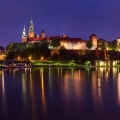The Camino de Levante-Sureste is one of the historic pilgrimage routes to Santiago de Compostela, crossing the Iberian Peninsula from east to west, beginning in Valencia, Alicante and Murcia, joining the three routes in Chinchilla de Monte-Aragón (Albacete), then passes through Toledo, Ávila, Zamora and Orense along the Camino Sanabrés; and through Valladolid to Astorga to join the Camino Francés. This approximately 1,200-kilometer Jacobean path has been followed for centuries by pilgrims from the Mediterranean.
What sets this route apart is its course through the heart of Spain, allowing pilgrims to explore the varied landscapes and rich cultural tapestry of the Spanish interior. As it winds through the province of Ávila (5 stages, 168 km), it connects pilgrims with the legacies of two remarkable women of universal stature: Teresa of Jesus and Isabella the Catholic.
The Camino de Santiago, in its Levante variant, enters the province of Ávila at a historically significant site: Los Toros de Guisando, ancient stone sculptures believed to date from the Iron Age. Though little is known about their origins, this site in the municipality of El Tiemblo witnessed a pivotal moment in Spanish history—the pact signed on September 19, 1468, in which Henry IV recognized his half-sister Isabella as the legitimate heir to the throne of Castile. Here, pilgrims can see the famed stone boars, silent witnesses to this defining event.
From Los Toros de Guisando, the route splits into a main path through Cebreros and San Bartolomé de Pinares, and an alternative path (preferably for cyclists) that traverses El Tiemblo and El Barraco. Both paths converge at Ávila, the home of one of Christianity’s most influential mystics.
Ávila: The City of Saint Teresa
Ávila, a key waypoint on the Camino, is also the starting point of the Teresian Route, a pilgrimage path tracing sites associated with Teresa of Jesus, the renowned Christian mystic. From the Basilica to the Convent of the Incarnation where she spent much of her religious life, and the Convent of San José, her first foundation, the Camino leads pilgrims through her story. Here, pilgrims experience both the Jacobean journey and the Teresian legacy.
Beyond the city walls, the Camino heads toward Gotarrendura across the Ávila plateau, through landscapes that Teresa herself walked numerous times. The views of Ávila’s walls along this stretch evoke the scenes Teresa once contemplated on her journeys.
The segment of the Camino de Santiago linking Ávila to Gotarrendura overlaps with a portion of the Teresian Route, immersing pilgrims in the landscapes that Saint Teresa frequented. Teresa traveled this path many times, visiting family lands in Gotarrendura, where a well-preserved dovecote still stands as a testament to her legacy.
The Legacy of Isabella the Catholic
Another milestone on the Camino de Santiago through Ávila is the town of Arévalo, where Isabella the Catholic spent part of her youth. This noble Castilian town holds important traces of her early years. As pilgrims walk its cobbled streets, they pass through the same spaces that shaped the future queen’s character and education.
The imposing Castle of Arévalo, overlooking the meeting of the Adaja and Arevalillo Rivers, was young Isabella’s residence. The town’s Plaza de la Villa, once the bustling center of Arévalo, preserves its medieval essence and invites pilgrims to imagine its lively past. The churches of San Martín and Santa María la Mayor, which Isabella frequented in her youth, stand as enduring testaments to her devoutness and are must-sees along the route.
From Arévalo, the Camino de Santiago leaves Ávila at Palacios de Goda, en route to Medina del Campo, the town where Isabella eventually passed away in 1504.
A Historical treasure trove
The Camino de Santiago through Ávila offers pilgrims a path to Compostela, and it also opens a door into the lives of two extraordinary women who left indelible marks on Spanish history. From Los Toros de Guisando, where Isabella’s destiny as queen was sealed, to the paths that Saint Teresa trod in her foundational work, the Jacobean route here intertwines with the legacies of these two iconic figures.
Today’s pilgrims follow these roads not only towards Santiago but also on a journey back in time, connecting with the lives and heritage of these remarkable women. Every step through Arévalo recalls the spirit of young Isabella, while the road to Gotarrendura brings to life Teresa of Jesus’ footsteps through this very land.
The experience is enriched by the artistic and monumental heritage left by these figures, making the Camino de Santiago through Ávila a journey where the spiritual aims of medieval pilgrims meet the historical and cultural curiosity of today’s traveler.




